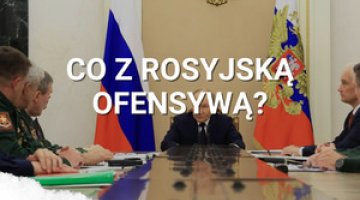Bakhmut is defending itself. Day 365 of the war

Russian forces made slight advances northwest of Bakhmut, as well as in the northern, eastern and southern parts of the town, approaching the centre. However, their attacks southwest of Bakhmut aimed at outflanking the town, and the attempts to expand the area they control on the western side of the Donetsk-Donbas canal, have failed. The Ukrainian defenders also repelled further attack attempts south of Siversk and west of Kreminna, in the Avdiyivka area, and in an arc west of Donetsk. According to some sources, however, Russian forces made a breach in the Ukrainian defences south of Mariyinka. The situation on the border of Luhansk and Kharkiv oblasts remains unclear; in this area the Russians intensified pressure on the defenders’ positions northeast of Kupyansk over the last few days. The invaders disconnected the mobile telephone and internet networks in parts of Luhansk oblast and the occupied part of Kharkiv oblast, thus masking the movements of their troops. According to the Ukrainian General Staff, the overall number of Russian attacks increased; the invading troops made 90 pushes on 22 February and 100 the following day.
On 22 February, the Russians launched another missile attack on the industrial infrastructure in Kharkiv. Their rockets fell on the outskirts of Zaporizhzhya and in that part of Donetsk oblast that remains under Ukrainian control. The invaders’ artillery and aviation continue to shell and bombard Ukrainian positions and the rear of their forces along the line of contact and in the border areas. Kherson, Nikopol and Ochakiv are still the most frequently shelled cities outside the combat areas. Acts of Ukrainian sabotage have occurred in Mariupol, where explosions were reported on 21 and 22 February; this includes the port, which some supplies for Russian units in the Kherson and Zaporizhzhya areas pass through.
According to Gen. Oleksiy Hromov, the deputy head of the Main Operational Directorate of the General Staff of the Ukrainian army, as of 24 February 2022 Russia had carried out nearly 5000 missile attacks, 3500 airstrikes and 1000 drones strikes against facilities on Ukrainian territory. Th prosecutor general Andriy Kostin, meanwhile, reported that since 10 October (when the first massive missile attack on Ukraine’s energy infrastructure was launched), the attackers have destroyed or damaged 112 energy infrastructure facilities in 255 targeted strikes.
The Pentagon has released details of the military support package which President Joe Biden announced while visiting Kyiv. It is valued at $460 million, and consists of missiles for HIMARS systems, 155 mm-calibre artillery ammunition, 120-mm mortar grenades, Javelin anti-tank guided missiles, 2000 anti-tank grenade launchers, 4 airspace surveillance radars, and 4 Bradley Fire Support Team forward observation vehicles. On 24 February, the United States announced another $2 billion military aid package for Ukraine; this will include more missiles for HIMARS systems, 155 mm-calibre artillery ammunition, laser-guided munitions for missile systems, CyberLux K8, Switchblade 600, Altius 600 and Jump 20 drones, as well as anti-drone systems.
The Spanish government has decided to transfer 6 Leopard-2A4 tanks to Ukraine. The country’s prime minister said while visiting Kyiv that Madrid will announce in the coming weeks whether it can raise this number to ten. Finland will provide Ukraine with 3 Leopard 2R heavy mine breaching vehicle, and will offer training in their use and operation; Helsinki has valued the entire support package at €160 million. On 24 February, Sweden announced that it will transfer 10 Leopard 2A5 tanks to Ukraine, as well as spare parts and ammunition for HAWK and IRIS-T air defence kits. On 24 February, the first platoon of Leopard 2A4 tanks (4 vehicles) from Poland arrived in Ukraine.
According to defence minister Oleksiy Reznikov, it is planned to form a minimum of two battalions of Leopard 2 tanks and six or seven battalions of Leopard 1 tanks in the Ukrainian army, but he did not address the fact that Kyiv’s partners have so far pledged only 59 Leopard 2 and 100 Leopard 1 tanks, which will equip just under two and just over three battalions respectively (at 31 tanks per battalion). British media have noted that Ukraine’s partners have not yet resolved the issue of how to replenish the losses that units equipped with Western tanks will suffer in combat.
Czech Prime Minister Petr Fiala has announced a total of €1.68 billion in military support to Ukraine (€421 million in government aid and €1.26 billion from the Czech defence industry, most likely through EU-funded projects). The Czechs have promised to supply 89 tanks, 226 armoured combat vehicles and 38 howitzers. According to the head of the defence ministry 38 tanks, 55 armoured combat vehicles, 13 self-propelled howitzers and 4 aircraft (most likely 4 Mi-24 helicopters), among other resources, have come from the country’s military reserves. The Czech Republic is also supplying Ukraine with inflatable mock-ups of armaments, including US HIMARS systems.
A disinformation operation accusing Kyiv of preparing an armed provocation is being conducted under the supervision of the Russian special services. On 23 February, the Russian defence ministry reported that Ukrainian forces are planning to invade Transnistria in the near future under the guise of repelling an alleged Russian offensive. Information is being circulated about Ukrainian troops being concentrated in the area, and that they are being re-routed from the Donbas to the border with Transnistria. On the same day, the Ukrainian Operational Command ‘North’ did not rule out the possibility that Russian forces are preparing provocations near the border of Chernihiv oblast. Ukrainian intelligence noted the movement of columns of military equipment in the border area: the vehicles had no identification markings, and the soldiers wore camouflage uniforms similar to Ukrainian ones. Oleksiy Danilov, secretary of the National Security and Defence Council of Ukraine, confirmed that the situation on the border had been discussed at a meeting with the president, and recalled that Ukrainian intelligence has previously reported on the likelihood of a Russian coup in Moldova. According to Danilov, the build-up of an atmosphere of tension in the Transnistria region is aimed at forcing Kyiv to divert some Ukrainian units there and weaken its forces in the east and south. However, he added that the Russian troop movements in the Chernihiv region had nothing to do with offensive actions.
After returning from Moscow, Belarusian president Alyaksandr Lukashenka convened a Security Council meeting on 20 February, during which a draft law entitled ‘On general conscription’ was considered. Its rationale emphasised that this new militarised formation, which is to number between 100,000 and 150,000 people (who are not subject to mobilisation), is being created to maintain order in territories where there are no military units (such as rural settlements or smaller towns) in the event of the imposition of martial law. The Belarusian defence ministry said on 21 February that close cooperation with the Russian Federation at the strategic level will continue. More than 150 joint training sessions are planned this year, including the major bilateral operational-level exercise entitled Union Shield-2023; this is scheduled to be held in Russia between 22-26 September.
The conflict between the Wagner Group’s owner and Russia’s military leadership continues. On 21 February, Yevgeny Prigozhin accused the defence ministry of trying to destroy his military company, calling it an act of treason. He claimed that defence minister Sergei Shoigu and the head of the General Staff Valery Gerasimov had forbidden the transfer of ammunition and logistical support to Wagner Group troops. The defence ministry has denied Prigozhin’s allegations, and accused him of using his mercenaries at the front in an arbitrary way, making the Ukrainian troops’ job easier.
According to information from Ukraine’s military intelligence service (HUR) which was revealed on 21 February, Russia is moving towards carrying out another wave of mobilisation, which will include students. So-called alert points are being set up to assist military commissions in serving summonses. No additional legal basis is needed for another wave of mobilisation, since the ‘partial mobilisation’ announced in September 2022 has not been officially wound up. According to HUR, the mobilisation will be carried out before 1 April, when formal military conscription for the spring period begins.
Ukrainian forces are continuing to launch cyberattacks in Russia. On 22 February, Russia’s Emergency Situations Ministry admitted that ‘unknown’ hackers had broken into the IT systems of radio stations in 10 cities (including Belgorod, Kazan, Nizhny Novgorod and Ufa), and broadcast a message declaring an air alert and the threat of a missile attack. A similar operation was carried out in Crimea, where local radio stations aired the Ukrainian national anthem and a statement by the head of HUR about the imminent recapture of the occupied peninsula. In the occupied territories of the Kherson region, the ‘passportisation’ of the local population is accelerating; the occupiers are threatening to evict all citizens who do not accept Russian documents.
Commentary
- The Ukrainian forces’ stubborn defence of the main combat areas is significantly slowing down the invaders’ progress. Despite having fire control over their last supply route to Bakhmut, the Russians have so far been unable to force the Ukrainian defenders to withdraw, and it is still not a foregone conclusion that they will succeed in closing the ring of encirclement around the town. In some combat zones, Ukrainian forces are succeeding in driving back the attacking troops to their previously held positions, and they have even occasionally been able to seize the initiative, as happened in the case of Vuhledar. The Russian breaks through the Ukrainian lines observed in recent weeks are local in nature, most often advancing the Russian positions by several hundred metres, and occasionally by up to several kilometres. It is difficult to estimate the losses incurred by either side, but the intensity and nature of the fighting indicate that both must be suffering high losses. However, they are continuing to direct reinforcements and reserves to the combat areas. It should thus be considered unlikely that the Russians will break through the Ukrainian defences in the Donbas on a wider front in the near future, or to build on their successes by moving to manoeuvring operations.
- The Russian disinformation operation suggesting that Ukraine could escalate the conflict in Transnistria or on the northern section of the border with Russia (near the border with Belarus) is primarily intended to distract Kyiv from events on the frontline and cause the Ukrainian forces to react in an over-hasty manner. This activity, which bears the characteristics of a psychological operation, is also intended to create a mood of war panic among the Moldovan public. Militarily, the Russians are not in a position to attack Moldova because of the low combat value and small size (about 1500 soldiers) of the Russian contingent in Transnistria. However, they will not give up their efforts to weaken Chisinau’s pro-Western course, and so a precisely targeted, limited armed provocation is not out of the question.




